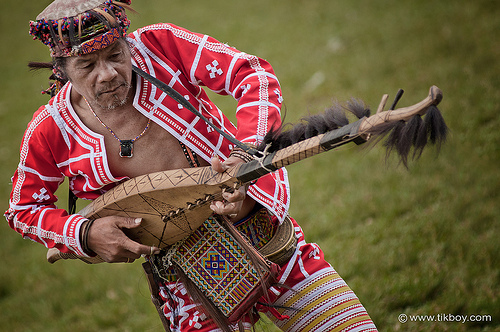The two-stringed lutes
by Fr. Joemar Sibug, OP (from his Slice of Life column)
 |
| photo courtesy Hans Brandeis |
I ARRIVED in Davao City for my new assignment last September 5, 2011. One of the things we needed for our mission house in Bajada was a bell. Our religious community uses the bell for our wake up call in the morning. We also use the bell to gather the members of our community, like for example at meal time and prayer time.
And so I tried to look for a bell in Aldevinco. I was hoping to find one that is “Mindanao inspired” and at the same time functional – one that would fit the purpose. Then I chanced upon this souvenir store that sells all sorts of “antiques” or old items. They have a wide range of items for sale – from small furniture, to house decors and traditional musical instruments of Mindanao. They also have what I was looking for – bells of various sizes and sounds. It took me a while to finally choose and buy a bell that will answer our need.
But what caught my attention was the array of two-stringed musical instruments that looked like a guitar. I thought of buying one that can be hung inside our house as a decoration. After a little haggling and bargaining with the seller, I got one that can serve as a wall décor.
A few weeks later, a friend of mine from Davao City told me that he will be in town for a few days. And so we agreed to meet. He happens to be a musician and he is a member of a band that plays world music. When we finally met in Davao City, I found out that his band plays music using the two-stringed lutes as one of their instruments. He also told me that he knows how to restore these instruments and that he actually collects them. When I told him that I bought one from Aldevinco, he wanted to see if it can be restored and if it can actually be played.
And so we went to our house and my friend started to fix the instrument that later on we were able to play music with. I found out from my friend that it is called by different names by various tribes in Mindanao. The T’bolis call it “hegalong”. The Manobos call it “kuglong”, while the B’laans call it “faglong”. Other tribes call it “kutyapi” or “kudyapi”.
 |
| photo source |
The basic features of this instrument are like the guitar. It has a hollow boat-shaped body, a neck with two tuning knobs and two strings. The two strings have the same tune, but only the lower string have frets attached to the neck with bees wax. The upper string is played as a drone, that is, it gives a monotone buzzing sound.
The two-stringed lutes do not have a big round hole in front, like the guitar. Its hole is usually at the back, so that the sound it makes emanate from it. I have found other two-stringed lutes with small holes in front of the body. The one who plays it usually positions the instrument close to his chest. My musician friend told me that it can be played anyway the player desired to play it. He said the “lumads” (indigenous people) usually play spontaneously and “from the heart”, that is why it is held close to the chest.
Horse hair adorn the neck of these two-stringed lutes. The more there are horse hair attached to the neck of the instrument means that its owner has many horses or that he is rich. The instrument is played while the player dances their native dance, making the horse hair sway to the movements of the dance.
Republished with permission from Fr. Joemar Sibug, OP. This article was first published in the Davao Catholic Herald Vol. 38 No. 19. September 30 – October 6, 2012

how do I play the kudyapi? c:
ReplyDeleteI have an advocacy page for the Boat Lutes of the Philippines on Facebook. There is a video section where you can see how they are played. Please, visit, join and share:
Deletettps://www.facebook.com/boatlutesphilippines/